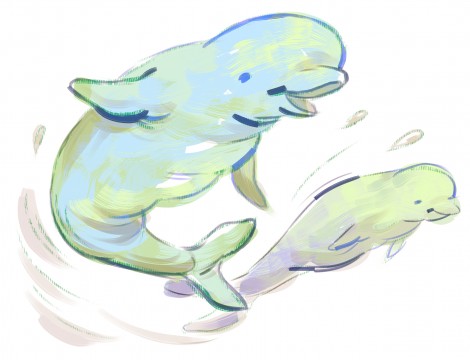Even though it’s June and it’s raining, nearly 200 people are hunkered down outdoors to watch as Qila, 800-kilos of arctic whale, hoists herself out of the water. Her leap is an impressive feat for an animal with a body fat ratio of 40 per cent. The crowd listens closely to her squeaks and whistles — belugas are nicknamed the “canaries of the sea” for their expansive vocal range — and shriek happily when Aurora, Qila’s mother, sends salty water their way with her tail flukes.
There’s a long history of training belugas to be part of shows. In fact, belugas were the first cetaceans — that’s whales, dolphins, and porpoises — to be displayed live. Yet the lives of the first captive beluga whales were very different to those of Qila and Aurora, and these differences say a lot about how much our views on marine life have changed over the last 200 years.
In the mid-1800s, when the first live belugas were captured, whales were part of a profitable and important industry. Right whales, bowheads, and other massive species were heavily hunted for oil and whalebone, the tough cartilaginous material used for corsets and umbrellas.
In 1861, a new business opportunity arose when Phineas Taylor (P.T.) Barnum — the same Barnum that co-founded the still-famous Barnum and Bailey Circus — heard that white whales had been netted in Canada’s St. Lawrence River. Barnum was a showman, and he knew the power that such unusual creatures had to draw a crowd.
Barnum hired a crew of 24 fishermen to capture live whales, and within days two belugas were on a train to New York. For over 1000 kilometers, the belugas travelled in wooden crates lined with seaweed.
This first pair of whales lived only a few days, their death attributed to the freshwater in their tank and the polluted air of the basement they were kept in. Yet in this short period, thousands of New Yorkers came to see them. Barnum had recognized and capitalized on the public’s appetite for sensationalism, adding the belugas to a collection of curiosities that included conjoined twins Chang and Eng Bunker, a trained seal named Ned, and the “Feejee mermaid” — in reality a preserved monkey’s torso attached to a fish’s tail. For Barnum, the belugas were a clever way to attract more visitors, offering them as spectacle themselves. The belugas in Barnum’s museum had very short life spans in captivity. By 1865, Barnum had captured and lost another six whales.
This summer, the Vancouver Aquarium’s Qila will celebrate her 18th birthday; she has spent all of them at the aquarium, where she was born in 1995. The dramatic change in life span from Barnum’s whales is due to great leaps in knowledge of the beluga’s biology and needs. Qila and Aurora live in a two million-litre habitat at the Vancouver Aquarium. They are fed a diet of restaurant-quality seafood, receive daily medical check-ups, and their trainers work them through a careful regimen of physical and mental exercises. “When it comes to our belugas,” says Nicole Cann, Manager of Interpretive Delivery at the Vancouver Aquarium, “we’re like the most overprotective parents ever.”
It’s not just how belugas are cared for that has changed. Daily beluga shows at the Vancouver Aquarium emphasize the connections between belugas and humans, showing how human activities can affect beluga ecology in the wild. Interpreters, staff members specifically trained to write and deliver educational programs, tell audiences about how noise and waste pollution, as well as changing ecosystems, impact wild beluga populations.
Unlike Barnum’s museum, the Vancouver Aquarium views itself primarily as an educational facility. Its shows and exhibits are designed to deliver a clear message about the importance of conservation.
“Just because we can see it”, says Cann of marine life, “doesn’t mean our grandchildren will be able to see it. Don’t take what we have for granted. Everything we experience isn’t guaranteed to us — we need to make the decision to protect what we have”.
This shifting perspective is part of a larger trend of zoos and aquaria reinventing themselves as centres for conservation and education. The Toronto Zoo, Canada’s largest zoo, puts just over 20 per cent of its gross annual budget towards education and conservation initiatives.
“Our messaging is getting through”, says Jennifer Derwojed, one of the Vancouver Aquarium’s interpretation specialists.
“Every animal has a role in their ecosystem. We also have a role — to protect these species. Hopefully people will gain awareness, connection, and appreciation. We’ve shifted our attitudes, and that ripples outwards. That’s how people view us; we’re a conservation organization.”



